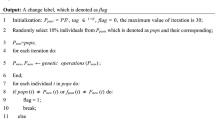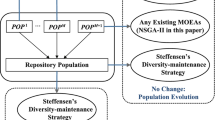Abstract
An essential feature of a dynamic multiobjective evolutionary algorithm (MOEA) is to converge quickly to the Pareto-optimal Set before it changes. In cases where the behavior of the dynamic problem follows a certain trend, convergence can be accelerated by anticipating the characteristics of future changes in the problem. A prediction model is usually used to exploit past information and estimate the location of the new Pareto-optimal Set. In this work, we propose the novel approach of tracking and predicting the changes in the location of the Pareto Set in order to minimize the effects of a landscape change. The predicted direction and magnitude of the next change, known as the predictive gradient, is estimated based on the history of previously discovered solutions using a weighted average approach. Solutions updated with the predictive gradient will remain in the vicinity of the new Pareto-optimal Set and help the rest of the population to converge. The prediction strategy is simple to implement, making it suitable for fast-changing problems. In addition, a new memory technique is introduced to exploit any periodicity in the dynamic problem. The memory technique selects only the more promising stored solutions for retrieval in order to reduce the number of evaluations used. Both techniques are incorporated into a variant of the multi-objective evolutionary gradient search (MO-EGS) and two other MOEAs for dynamic optimization and results indicate that they are effective at improving performance on several dynamic multiobjective test problems.
Similar content being viewed by others
References
Arnold DV, Salomon R (2007) Evolutionary gradient search revisited. IEEE Trans Evol Comput 11: 480–495
Bosman PAN (2005) Learning, anticipation and time—deception in evolutionary online dynamic optimization. In: Proceedings of the 2005 workshops on genetic and evolutionary computation, pp 39–47
Bosman PAN, de Jong E (2005) Exploiting gradient information in numerical multi-objective evolutionary optimization. In: Proceedings of the 2005 conference on genetic and evolutionary computation, pp 755–762
Bosman PAN, de Jong E (2006) Combining gradient techniques for numerical multi-objective evolutionary optimization. In: Proceedings of the 8th annual conference on genetic and evolutionary computation, pp 627–634
Branke J (2001) Evolutionary optimization in dynamic environments. Kluwer, Norwell, pp 14–17
Branke J, Schmeck H (2002) Designing evolutionary algorithms for dynamic optimization problems. In: S. Tsutsui and A. Ghosh (eds), Theory Appl Evol Comput Recent Trends pp 239–262
Brown M, Smith RE (2003) Effective use of directional information in multi-objective evolutionary computation. In: Proceedings of the 2003 genetic and evolutionary computation conference, pp 778–789
Brown M, Smith RE (2005) Directed multiobjective optimization. Int J Comput Syst Signals 6(1): 3–17
Caponio A, Cascella GL, Neri F, Salvatore N, Sumner M (2007) A fast adaptive memetic algorithm for online and offline control design of PMSM drives. IEEE Trans Syst Man Cybern B 37(1): 28–41
Cobb HG (1990) An investigation into the use of hypermutation as an adaptive operator in genetic algorithms having continuous, time-dependent nonstationary environments. Technical Report AIC-90-001, Naval Research Laboratory, Washington, DC
Craveirinha J, Martins L, Gomes T, Antunes CH, Clìmaco J (2003) A new multiple objective dynamic routing method using implied cost. J Telecomm Inf Technol 3: 51–59
Deb K, Agrawal RB (1995) Simulated binary crossover for continuous search space. Complex Syst 9: 115–148
Deb K, Thiele L, Laumanns M, Zitzler E (2001) Scalable test problems for evolutionary multi-objective optimization. TIK Report 112, Computer Engineering and Networks Laboratory (TIK), ETH Zurich
Deb K, Pratap A, Agarwal S, Meyarivan T (2002) A fast and elitist multi-objective genetic algorithm: NSGA-II. IEEE Trans Evol Comput 6: 181–197
Deb K, Rao UBN, Karthik S (2006) Dynamic multi-objective optimization and decision-making using modified NSGA-II: a case study on hydro-thermal power scheduling bi-objective optimization problems. Kanpur Genetic Algorithms Lab (Kan-GAL), Indian Institue of Technology, Technical Report 2006008
Fleischer M (2003) The measure of Pareto optima. Applications to multiobjective Metaheuristics. In: Proceedings of the second international conference on evolutionary multi-criterion optimization, vol 2632, pp 519–533
Farina M, Deb K, Amato P (2004) Dynamic multiobjective optimization problems: test cases, approximations, and applications. IEEE Trans Evol Comput 8: 425–442
Fonseca CM, Fleming PJ (1995) Multiobjective genetic algorithms made easy: selection, sharing and mating restriction. In: First IEEE international conference on genetic algorithms in engineering systems: innovations and applications, pp 45–52
Goh CK, Ong YS, Tan KC (2008) An investigation on evolutionary gradient search for multi-objective optimization. In: Proceedings of 2008 IEEE congress on evolutionary computation, pp 3742–3747
Goh CK, Tan KC (2009) A competitive-cooperative coevolutionary paradigm for dynamic multi-objective optimization. IEEE Trans Evol Comput 13: 103–127
Goh CK, Tan KC (2009) Evolutionary Multi-objective Optimization in Uncertain Environments: Issues and Algorithms. Springer-Verlag, Berlin
Kursawe F (1990) A variant of evolution strategies for vector optimization. In: Proceedings of the 1st workshop on parallel problem solving from nature, vol 496, pp 193–197
Harada K, Sakuma J, Kobayashi S (2006) Local search for multiobjective function optimization: pareto descent method. In: Proceedings of the 8th annual conference on genetic and evolutionary computation, pp 659–666
Hatzakis I, Wallace D (2006) Dynamic multi-objective optimization with evolutionary algorithms: a forward-looking approach. In: Proceedings of the 8th annual conference on genetic and evolutionary computation, pp 1201–1208
Hart WE, Krasnogor N, Smith JE (2004) Editorial introduction, Special issue on memetic algorithms. Evol Comput 12(3):v–vi
Hart WE, Krasnogor N, Smith JE (2005) Recent advances in memetic algorithms. Springer, Berlin
Heo JS, Lee KY, Garduno-Ramirez R (2006) Multiobjective control of power plants using particle swarm optimization techniques. IEEE Trans Energy Convers 21(2): 552–561
Hughes EJ (2008) Fitness assignment methods for many-objective problems. In: Multiobjective problem solving from nature. Springer, Berlin, pp 318–319
Huy NQ, Ong YS, Lim MH (2009) Adaptive cellular memetic algorithms. Evol Comput 17(2): 231–256
Ishibuchi H, Murata T (1996) Multi-objective genetic local search algorithm. In: Proc. of 1996 IEEE international conference on evolutionary computation, Nagoya, Japan, pp 119–124
Ishibuchi H, Murata T (1998) A multi-objective genetic local search algorithm and its application to flowshop scheduling. IEEE Trans Syst Man Cybern C Appl Rev 28(3): 392–403
Jaszkiewicz A (2002) On the performance of multiple-objective genetic local search on the 0/1 Knapsack problem-a comparative experiment. IEEE Trans Evol Comput 6(4): 402–412
Jin Y, Okabe T, Sendhoff B (2001) Adapting weighted aggregation for multiobjective evolution strategies. In: Proceedings of the first conference on evolutionary multi-criterion optimization, pp 96–110
Kersting S, Raidl GR, Ljubic I (2002) A memetic algorithm for vertex-biconnectivity augmentation. In: Proceedings of the applications of evolutionary computing on evo workshops, pp 102–111
Knowles JD, Corne DW (1999) The Pareto archived evolution strategy: a new baseline algorithm for Pareto multiobjective optimization. In: Proceedings of the 1999 congress on evolutionary computation, vol 1, pp 98–105
Knowles JD, Corne DW (2000) M-PAES: a memetic algorithm for multi-objective optimization. In: Proceedings of the 2000 congress on evolutionary computation, pp 325–332
Krasnogor N, Smith J (2005) A tutorial for competent memetic algorithms: model, taxonomy, and design issues. IEEE Trans Evol Comput 9: 474–488
Leskinen J, Neri F, Neittaanmäki P (2009) Memetic variation local search vs. life-time learning in electrical impedance tomography, pp 615–624, EvoWorkshops
Morrison RW, De Jong KA, Syst M, McLean VA (2000) Triggered hypermutation revisited In: Proceedings of the 2000 congress on evolutionary computation, vol 2, pp 1025–1032
Nguyen QH, Ong YS, Lim MH (2009) A probabilistic memetic framework. IEEE Trans Evol Comput 13(3): 604–623
Ong YS, Lim MH, Zhu N, Wong KW (2006) Classification of adaptive memetic algorithms: a comparative study. IEEE Trans Syst Man Cybern B 36(1): 141–152
Ong YS, Krasnogor N, Ishibuchi H (2007) Special issue on memetic algorithms. IEEE Trans Syst Man Cybern B 37(1): 2–5
Ong YS, Lum KY, Nair PB (2008) Evolutionary algorithm with Hermite radial basis function interpolants for computationally expensive adjoint solvers. Comput Optim Appl 39(1): 97–119
Salomon R (1998) Evolutionary algorithms and gradient search: similarities and differences. IEEE Trans Evol Comput 2: 45–55
Salomon R (1998) Accelerating the evolutionary-gradient-search procedure: individual step sizes. In: Fifth international conference on parallel problem solving from nature, pp 408–417
Tan KC, Khor EF, Lee TH, Sathikannan R (2003) An evolutionary algorithm with advanced goal and priority specification for multi-objective optimization. J Artif Intell Res 1: 183–215
Tirronen V, Neri F, Majava K, Kärkkäinen T (2008) The natura non facit saltus principle in Memetic computing. In: IEEE congress on evolutionary computation, pp 3881–3888
Tung L-F, Lin L, Nagi R (1999) Multiple-objective scheduling for the hierarchical control of flexible manufacturing systems. Int J Flexible Manuf Syst 11(4): 379–409
Wineberg M, Oppacher F (2000) Enhancing the GAs ability to cope with dynamic environments. In: Proceedings of the 2000 genetic and evolutionary computation congress, p 310
Zeng S et al. (2006) A dynamic multi-objective evolutionary algorithm based on an orthogonal design. In: IEEE congress on evolutionary computation, pp 573–580
Zhang Q, Li H (2007) MOEA/D: a multi-objective evolutionary algorithm based on decomposition. IEEE Trans Evol Comput 11(6): 712–731
Zhang Z (2005) Multiobjective optimization immune algorithm in dynamic environments and its application to greenhouse control. In: Proceedings of the 2005 IEEE congress on evolutionary computation, pp 714–719
Zitzler E (1999) Evolutionary algorithms for multiobjective optimisation: methods and applications. PhD thesis, Swiss Federal Institute of Technology (ETH), Zurich, Switzerland
Zitzler E, Laumanns M, Thiele L (2001) SPEA2: improving the strength Pareto evolutionary algorithm for multiobjective optimization. Technical Report 103, Computer Engineering and Networks Laboratory, Swiss Federal Institute of Technology Zurich
Author information
Authors and Affiliations
Corresponding author
Rights and permissions
About this article
Cite this article
Koo, W.T., Goh, C.K. & Tan, K.C. A predictive gradient strategy for multiobjective evolutionary algorithms in a fast changing environment. Memetic Comp. 2, 87–110 (2010). https://doi.org/10.1007/s12293-009-0026-7
Received:
Accepted:
Published:
Issue Date:
DOI: https://doi.org/10.1007/s12293-009-0026-7




